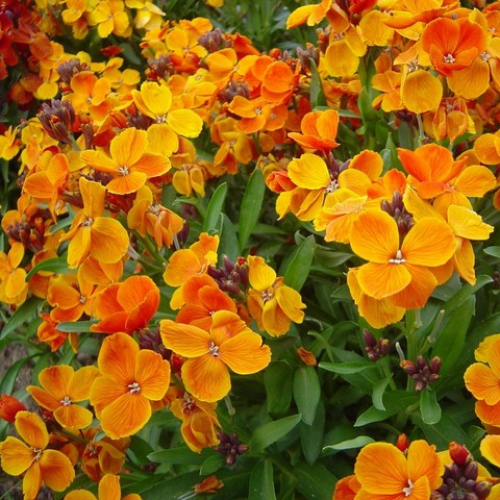Perennials Cheiranthus

Description
Characteristic Features of Erysimum
Erysimum (Cheiranthus) belongs to the genus Erysimum in the family Cruciferae or Brassicaceae. This plant is also called Wallflower or Gillyflower. Wallflower is an early-flowering evergreen perennial, frequently grown as an annual or biennial. Its attractively shaped and coloured flowers have a pleasant fragrance. The plant is native to the Mediterranean but nowadays you can also find wild Erysimum in America, the Crimea, and the Caucasus.
The stems are thin and covered with hairs, branchy or erect, 25 to 100 centimetres in height. However, mostly undersized species (up to 45 centimetres tall) are cultivated as ornamental plants. The leaves are narrow, lanceolate, toothed in the margins, slightly wrinkled or smooth, similar to the leaves of the lily of the valley. The flowers (approximately 2 centimetres across) have 4 petals and are collected in racemoses. The flowers can be simple or double, with the colour varying from white and yellow to reddish brown to purple. Many varieties bloom in April, while others please the eye with their charming flowers from mid-summer to late autumn. The fruit is an elongated four-sided pod with small light brown seeds that remain viable for up to four years. One gram contains about 500 seeds. Remember to handle the seeds with care because they contain toxic glycoside.
In the wild, you can find Cheiranthus alpines that grows up to 40 centimetres tall and has dark green leaves and typically yellow flowers; Cheiranthus cheiri that reaches 60 centimetres tall and has golden, brownish, or purple flowers; Cheiranthus mutabilis that grows to about 80 centimetres tall and is noted for bright variously coloured flowers that darken at the end of flowering; and Cheiranthus allionii, a hybrid plant with orange yellow flowers.
In landscaping, mostly hybrid varieties are used. Below is a list of the most popular ones:
'Tom Thumb' only grows 20 centimetres tall and has golden, dark red, or brownish flowers.
'Bedder' is also a low-growing plant with golden, orange, or red flowers.
'Golgkonig' grows to about half a metre in height and has golden yellow inflorescences.
'Cloth of Gold' grows about 40 centimetres tall and has golden flowers.
'Gefulitre Zwergbusch' is a low shrub with double flowers.
'Fire King' has fiery scarlet flowers.
'Purple Queen' has very dark flowers.
'Harlequin' has bicolour flowers.
In garden and parks, Erysimum is grown in flower borders, mixed borders, on stony hills, and in flower beds under the windows. The best companions are tulips, daffodils, forget-me-nots, violets, and lilac. This plant looks great in containers for decoration of windows, balconies, and porches. Erysimum is good for cutting. Thanks to the content of essential oil in the leaves and flowers, it has been for many years used as a medicinal plant in the alternative medicine as well as for cosmetic treatments.
The Secrets to Successfully Growing Erysimum
Erysimum prefers sunny areas with loose calcareous or loamy soils and does not tolerate waterlogging, so good drainage is a prerequisite for successful cultivation. Work in compost, peat, or mineral fertilizer prior to planting to ensure profuse flowering. However, remember not to plant Erysimum in the places where cruciferous plants were grown as it can get clubroot.
The basic care includes moderate watering in dry weather; tipping for better branching; spring pruning of old or damaged shoots; regular fertilizing; and deadheading spent flowers.
Erysimum withstands temperatures down to -18 ° C and can overwinter in fairly warm regions without sheltering. In the northern regions, this plant is often potted, kept in the greenhouse, and planted out in the spring, or alternatively, sheltered with spruce branches or dry leaves.
Erysimum is propagated from seeds. Surface sow the seeds outdoors before winter or in April-June. Erysimums are self-sowers. The best temperature for germination is +15 ° C. When a few leaves develop, thin out the seedlings to make sure the plants are spaced 15-25 centimetres apart. For earlier flowering, some growers sow the seeds in February and March in containers and plant out the young plants in May. Erysimum typically blooms 4 months after sowing.
Potential Problems
Sometimes Erysimum can be affected by white rust. Leaves and stems get distorted and white spores appear on them. To prevent the disease, avoid waterlogging and go easy on nitrogen fertilizer. If the disease persists, remove the affected plants and treat the remaining plants with fungicides.
In general, Erysimum is prone to a variety of fungal diseases, so avoid planting it in acidic soils. Keep the soil moist but not waterlogged. Allow the soil dry out between waterings.
Sometimes Erysimum may be affected by the cruciferous flea beetle. Control pests with special insecticides.







 83 825
83 825







